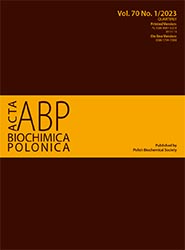P2X7 receptor in normal and cancer cells in the perspective of nucleotide signaling
Abstract
Nucleotides are the most common compounds produced constantly by living organisms. They are involved in most cellular processes like the synthesis of other nucleotides and nucleic acids, generation of energy needed for the maintenance of cells, and molecular signaling. In the 70s sir. Geoffrey Burstock discovered a new class of transmembrane proteins – nucleotide receptors responding to nucleotides and their derivatives. For historical reasons, we distinguish two main classes of nucleotide receptors: P1 – which are G protein-coupled adenosine receptors, and P2 – nucleotide receptors that respond to ATP and its derivatives. Additionally, the P2 receptors family can be divided into two subgroups: P2Y – G protein-coupled receptors and P2X cation channel receptors. This paper focuses mainly on the most researched receptor in the nucleotide receptors family – the P2X7 receptor – presenting it in the background of the nucleotide signaling landscape. Almost thirty years of extensive studies on the receptor contributed to understanding protein structure, splicing variants, and mechanism of action in somatic cells. Despite such a wide spectrum of research, the role of the receptor in cancer progression is still undetermined. In many reports, we can find information about the anti-tumorigenic role of this receptor caused by activation of the cell death mechanism after membrane pore formation. These results, however, contradict other studies in which the same receptor is known to promote cancer development through stimulation of proliferation and activation of pro-survival pathways. Ultimately, all this gathered knowledge points to two faces of the receptor in tumor progression. Therefore, we do provide a comprehensive overview of the topic. Finally, we also try to systemize previous and recent literature about the role of this receptor in somatic and cancer cells and provide access to it in the form of a convenient table.
Acta Biochimica Polonica is an OpenAccess quarterly and publishes four issues a year. All contents are distributed under the Creative Commons Attribution-ShareAlike 4.0 International (CC BY 4.0) license. Everybody may use the content following terms: Attribution — You must give appropriate credit, provide a link to the license, and indicate if changes were made. You may do so in any reasonable manner, but not in any way that suggests the licensor endorses you or your use.
Copyright for all published papers © stays with the authors.
Copyright for the journal: © Polish Biochemical Society.


